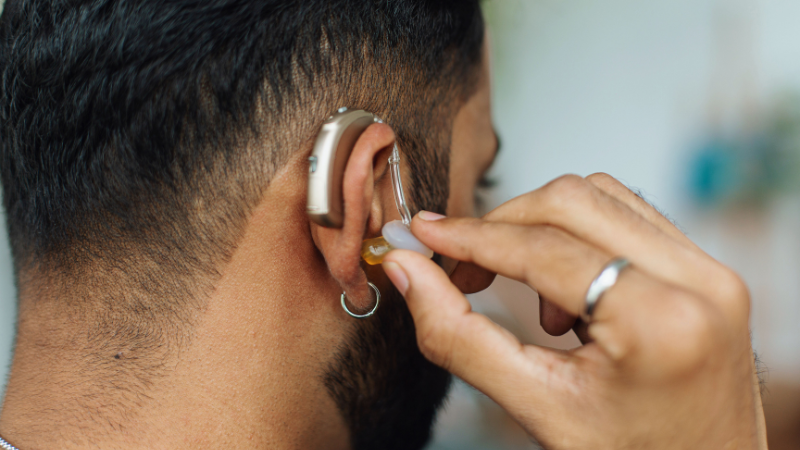If you or a loved one is experiencing hearing loss, you may be considering options to help improve your hearing. Two popular options are hearing aids and hearing amplifiers. While they may seem similar, there are important differences between the two that can affect your decision. In this article, we will explore the differences between hearing aids and amplifiers, as well as factors to consider when choosing between the two.
In This Guide:
When it comes to hearing devices, there are two main options: hearing aids and hearing amplifiers. Here are some key takeaways to keep in mind when deciding between the two:
- Hearing aids are medical devices that are regulated by the FDA and are designed to help people with hearing loss. They are custom-fitted to your ear and programmed to amplify specific frequencies based on your hearing test results.
- Hearing amplifiers, on the other hand, are not regulated by the FDA and are often marketed as “personal sound amplification products.” They are designed to amplify all sounds, not just the frequencies you have trouble hearing, and are not customized to your specific hearing needs.
- While hearing amplifiers may be less expensive than hearing aids, they are not a substitute for medical treatment for hearing loss. If you are experiencing hearing loss, it is important to see a hearing healthcare professional to get a hearing test and proper diagnosis and treatment plan.
- Hearing aids come in a variety of styles, including behind-the-ear, in-the-ear, and receiver-in-canal. The style that’s right for you will depend on your specific hearing needs and personal preferences.
- Hearing aids can be expensive, but there are options available to help make them more affordable. Some insurance plans cover the cost of hearing aids, and there are also programs that provide financial assistance to those who qualify.
- It’s important to take good care of your hearing devices to ensure they last as long as possible. This includes cleaning them regularly, storing them properly, and avoiding exposure to moisture and extreme temperatures.
Video: Hearing Aid or Amplifier: Which Is Right For You?
Understanding Hearing Aids
Hearing aids are small electronic devices that are designed to improve your hearing by amplifying sounds and making them louder and clearer. They are highly personalized and available in different styles and colors, making it easier to find a hearing aid that suits your preferences. In this section, we will discuss the different types of hearing aids available and their advantages and disadvantages.
Behind-the-Ear (BTE) Hearing Aids

Behind-the-ear (BTE) hearing aids sit behind the ear and are connected to a custom-molded earpiece by a tube. The electronic components of the hearing aid are housed in a small plastic case that sits behind the ear, while the earpiece is placed in the ear canal. BTE hearing aids are known for their durability and power, making them a popular choice for people with severe to profound hearing loss. They are also relatively easy to adjust and maintain and can accommodate a variety of additional features such as telecoils, directional microphones, and Bluetooth connectivity.
BTE hearing aids are available in various colors and styles, making them a versatile and customizable option for those with hearing loss.
In-the-Ear (ITE) Hearing Aids

In-the-ear (ITE) hearing aids are custom-molded to fit directly inside the ear. The electronic components of the hearing aid are contained within a small plastic casing that fits snugly in the ear. ITE hearing aids are available in various sizes, from the larger Full Shell models that fill up most of the visible part of the outer ear to the smaller Completely-in-Canal (CIC) models that are almost invisible.
ITE hearing aids are popular for their discreet design and ease of use. They can be fitted with additional features such as directional microphones, volume controls, and telecoils. They can also be customized to match the user’s skin or hair color. Overall, ITE hearing aids are a versatile and customizable option for those with mild to moderate hearing loss looking for a discreet and convenient solution.
In-The-Canal (ITC) Hearing Aids
In-the-canal (ITC) hearing aids sit inside the ear canal but not as deeply as completely-in-canal (CIC) models. The electronic components of the hearing aid are housed in a small plastic casing that fits into the lower part of the outer ear canal, making them less visible than behind-the-ear (BTE) hearing aids. ITC hearing aids are custom-molded to fit the shape of the user’s ear and are available in a range of skin-tone colors. They are suitable for people with mild to moderate hearing loss and are designed to be discreet and comfortable to wear.
ITC hearing aids can include additional features such as volume controls, telecoils, and directional microphones and are typically easier to handle than smaller CIC models. Overall, ITC hearing aids offer a good balance of discreet design and performance, making them a popular choice for many people with hearing loss.
Completely-In-the-Canal (CIC) Hearing Aids
Completely-in-the-canal (CIC) hearing aids sit deep inside the ear canal, making them virtually invisible from the outside. The electronic components of the hearing aid are contained within a small plastic casing that fits snugly in the ear canal. They offer excellent sound quality and are custom-molded to fit the unique shape of the user’s ear, providing a comfortable and secure fit.
CIC hearing aids are typically smaller and more discreet than other types of hearing aids, making them an excellent choice for people who want a highly discreet and subtle hearing aid solution. Because they sit so deeply in the ear canal, CIC hearing aids can be prone to problems such as earwax buildup, and they may not be suitable for people with severe hearing loss.
In summary, each type of hearing aid has its advantages and disadvantages, and it’s important to speak with a professional to determine which one is right for you. BTE hearing aids are known for their durability and power, while ITE hearing aids are popular for their discreet design and ease of use. ITC hearing aids offer a good balance of discreet design and performance, while CIC hearing aids are the most discreet and subtle hearing aid solution.
Understanding Hearing Amplifiers
If you have mild to moderate hearing loss, hearing amplifiers can be a viable solution to improve your hearing. Unlike hearing aids, which require professional programming and are highly personalized, amplifiers are a more affordable and easily accessible option. There are several types of hearing amplifiers available, including over-the-counter (OTC) amplifiers, personal sound amplifiers (PSAs), and TV amplifiers.
There are several different types of amplifiers available, including:
Over-the-Counter (OTC) Amplifiers
OTC amplifiers are PSAPs designed to amplify sound for people with mild to moderate hearing loss. They are readily available for purchase without needing a prescription and are often less expensive than traditional hearing aids. OTC amplifiers are a good option for people with mild hearing loss looking for an affordable and easily accessible solution. However, they are not as effective as hearing aids and may be harmful to the user’s hearing if used improperly.
OTC amplifiers lack the sophisticated features and customization options of traditional hearing aids, making them less optimal for people with more severe hearing loss. They are not a substitute for a professional hearing evaluation and the appropriate treatment plan recommended by a hearing healthcare professional
Personal Sound Amplifiers (PSAs)
PSAs are electronic devices designed to amplify sound for people with mild to moderate hearing loss. They are similar in appearance to traditional hearing aids, but they are not classified as medical devices and do not require a prescription to purchase.
PSAs can benefit people with mild hearing loss, but they lack the sophisticated features and customization options of traditional hearing aids. Additionally, they may be harmful to the user’s hearing if used improperly. PSAs are not regulated by the FDA like hearing aids, and their quality and effectiveness can vary widely.
Overall, PSAs may be a good option for people with mild hearing loss who are looking for an affordable and easily accessible solution. However, they are not a substitute for a professional hearing evaluation and the appropriate treatment plan recommended by a hearing healthcare professional.
TV Amplifiers
TV amplifiers are PSAPs designed to amplify sound from a television or other audio device for people with hearing loss. They pick up the audio signal from the TV or audio device and transmit it directly to the user’s hearing aid or headphones. This can help people with hearing loss to hear the audio more clearly and at a higher volume without disturbing others in the room.
TV amplifiers are typically easy to use and can be connected to the TV or audio device using a variety of cables or wireless technologies such as Bluetooth. While TV amplifiers can be a helpful solution for people with hearing loss, they are not a substitute for a professional hearing evaluation and the appropriate treatment plan recommended by a hearing healthcare professional.
In conclusion, hearing amplifiers can be a viable solution for people with mild to moderate hearing loss. However, they are not a substitute for a professional hearing evaluation and the appropriate treatment plan recommended by a hearing healthcare professional. It is important to consult with a hearing healthcare professional to determine the best solution for your specific hearing needs.
Differences between Hearing Aids and Amplifiers
When it comes to hearing aids and amplifiers, there are several key differences to keep in mind. Hearing aids are highly personalized and require professional programming, while amplifiers are a “one size fits all” solution. Additionally, hearing aids are designed to amplify specific frequencies and sounds, while amplifiers amplify all sounds, including background noise.
If you have moderate to severe hearing loss, a hearing aid is likely the better option. Hearing aids are highly personalized and can be programmed to amplify specific frequencies and sounds based on your unique needs. This makes them much more effective than amplifiers in noisy environments.
However, if you have mild to moderate hearing loss and are looking for a cheaper option, an amplifier may be a good choice. Amplifiers can help improve your hearing in quiet environments but may be less effective in noisy environments.
Here are some of the key differences between hearing aids and amplifiers:
| Hearing Aids | Amplifiers |
|---|---|
| Highly personalized and require professional programming | “One size fits all” solution |
| Designed to amplify specific frequencies and sounds | Amplify all sounds, including background noise |
| More effective in noisy environments | Less effective in noisy environments |
| More expensive | Cheaper option |
| Covered by insurance plans | Not typically covered by insurance plans |
It is important to consult with a hearing healthcare professional to determine which option is best for your unique needs and degree of hearing loss.
Factors to Consider
When deciding between a hearing aid and an amplifier, there are several factors to consider to ensure you choose the best device for your individual needs. These factors include your lifestyle and communication needs, insurance coverage, and the price of the device.
Lifestyle and Communication Needs

Your lifestyle and communication needs play a significant role in determining which device is right for you. If you are an active person who frequently attends social events, you may benefit from a hearing aid with noise-reduction features. This feature can help reduce background noise and improve your ability to hear in noisy environments. If you spend a lot of time on the phone, you may want to consider a hearing aid with Bluetooth connectivity to make phone calls easier.
If you spend a lot of time in environments with high levels of background noise, such as restaurants or public transportation, you may benefit from a hearing aid with directional microphones. These microphones can help reduce background noise and improve your ability to hear in noisy environments.
Insurance Coverage
Before purchasing a hearing aid or amplifier, it is important to check with your insurance provider to see what coverage is available. Some insurance plans may cover some or all of the cost of a hearing aid or amplifier. However, coverage can vary widely depending on your plan and provider.
If you have insurance coverage, it may be beneficial to purchase a device through an insurance-approved provider to ensure maximum coverage. This can help reduce the out-of-pocket cost of the device and make it more affordable.
Price
The cost of a hearing aid or amplifier can vary widely depending on the type and features of the device. Amplifiers are generally less expensive than hearing aids, with prices ranging from under $50 to a few hundred dollars. However, they may not be as effective as hearing aids, particularly in noisy environments.
Hearing aids may cost as little as a few hundred dollars. However, more advanced models with additional features such as Bluetooth connectivity and noise reduction can cost several thousand dollars. It is important to keep in mind that while cost is an important factor to consider, it should not be the only factor. When choosing a device, it is important to consider your individual needs and lifestyle to ensure you choose a device that will provide the most benefit.
When considering the cost of a device, it is also important to factor in the cost of regular maintenance and servicing. Regular maintenance and servicing can help prolong the life of your device and ensure it continues to work properly.
When choosing a device, it’s important to consider your budget and what features are most important to you. It’s also important to factor in the cost of regular maintenance and servicing, which can help prolong the life of your device and ensure it continues to work properly.
New Advancements in Hearing Aid and Amplifier Technology
Advancements in hearing aid and amplifier technology have made significant improvements to the user experience in recent years. Here are some of the latest advancements and how they can benefit you.
Rechargeable Batteries
One significant advancement in hearing aid technology is the development of rechargeable batteries. This eliminates the need to frequently change batteries, making the device more convenient and cost-effective. Rechargeable batteries also reduce the environmental impact of disposable batteries.
Artificial Intelligence

Another exciting advancement in hearing aid technology is the use of artificial intelligence (AI). AI technology is increasingly being integrated into hearing aids to improve their performance and enhance the listening experience for users.
AI-powered hearing aids can automatically adjust their settings based on the user’s listening environment, such as reducing background noise in a crowded restaurant or amplifying speech in a quiet room. They can also learn the user’s preferences over time and adapt accordingly.
Additionally, some hearing aids are equipped with AI-powered speech recognition, which can help users understand speech more clearly, even in challenging listening situations. Overall, AI technology is making hearing aids smarter and more effective at addressing hearing loss.
Directional Microphones
Directional microphones are another advancement in hearing aid technology. These microphones are designed to pick up sound from a specific direction, rather than amplifying all sounds equally. This can help users focus on the sound they want to hear, such as a conversation with a friend, while reducing background noise.
Bluetooth
Bluetooth technology is increasingly being integrated into hearing aids to provide users with a more seamless and convenient listening experience. With Bluetooth-enabled hearing aids, users can wirelessly connect their hearing aids to various devices such as smartphones, tablets, and televisions. This allows them to stream audio directly to their hearing aids, eliminating the need for additional wires or devices.
Bluetooth-enabled hearing aids can also allow for hands-free phone calls and make it easier for users to participate in conference calls or listen to music. Overall, Bluetooth technology is helping to improve the accessibility and convenience of hearing aids for users.
These advancements in hearing aid and amplifier technology are making a significant impact on the lives of those with hearing loss. With improved sound quality, noise reduction, wind noise reduction, and Bluetooth capability, users can enjoy a better listening experience and a higher quality of life.
Common Misconceptions About Hearing Aids and Amplifiers
When it comes to hearing aids and amplifiers, there are several common misconceptions that can make it challenging to make an informed decision. This section will clarify some of these misconceptions and provide the truth behind them.
Misconception 1
Hearing Aids and Amplifiers are the Same Thing
Many people assume that hearing aids and amplifiers are the same thing. However, this is not true. While both devices amplify sound, hearing aids are medical devices specifically designed to improve hearing for individuals with hearing loss. They are regulated by the FDA and require a prescription from a licensed audiologist. Amplifiers, on the other hand, are not regulated and can be purchased over the counter without a prescription. They are designed to simply amplify sound for individuals who do not have hearing loss.
Misconception 2
Hearing Aids and Amplifiers Will Restore Hearing to Normal
Another common misconception is that hearing aids and amplifiers will restore hearing to normal. Unfortunately, this is not the case. While hearing aids can help improve hearing and reduce the impact of hearing loss, they cannot restore hearing to normal. It’s important to have realistic expectations when using these devices.
Misconception 3
All Hearing Aids and Amplifiers are Expensive
Finally, many people assume that all hearing aids and amplifiers are expensive. While some devices can be quite costly, there are also more affordable options available. Additionally, insurance coverage may be available to help offset the cost of a hearing aid, and some providers may offer financing options to make the device more affordable.
It’s important to keep in mind that while cost is an important factor to consider, it should not be the only factor. When choosing a device, it’s important to consider your individual needs and lifestyle to ensure you choose a device that will provide the most benefit. It’s also important to note that hearing aids and amplifiers are intended for different purposes and should be used accordingly. Hearing aids are designed to help individuals with hearing loss, while amplifiers are intended for individuals without hearing loss who simply want to amplify sound.
How to Care for Your Hearing Aid or Amplifier
If you want to ensure that your hearing aid or amplifier continues to work properly, it’s important to take good care of it. Here are some tips to help you care for your device:
Cleaning Your Hearing Aid or Amplifier
Regular cleaning is essential to ensure that your hearing aid or amplifier continues to function properly. Here are some tips for cleaning your device:
- Use a soft, dry cloth to clean your device.
- Avoid getting your device wet.
- Use a cleaning kit specifically designed for hearing aids or amplifiers.
Changing Batteries
Keeping your hearing aid or amplifier powered up is crucial for optimal performance. Here are some tips for changing your batteries:
- Follow the manufacturer’s instructions for changing the batteries.
- Keep spare batteries on hand.
Storing Your Hearing Aid or Amplifier
Proper storage can help prevent damage to your hearing aid or amplifier. Here are some tips for storing your device:
- Store your device in a cool, dry place.
- Keep your device away from pets and children.
Regular Maintenance
Regular maintenance can help keep your hearing aid or amplifier in good working order. Here are some tips for maintaining your device:
- Have your hearing aid or amplifier professionally cleaned and serviced on a regular basis.
- Check for any damage or wear and tear on your device.
By following these tips, you can help prolong the life of your hearing aid or amplifier and ensure that it continues to work properly. Don’t forget to check your device’s warranty for any additional care instructions or recommendations. Additionally, there are various accessories available such as earwax guards, replacement tubes, and speakers that can help keep your device in tip-top shape.
FAQs
Here are some frequently asked questions about hearing aids and amplifiers:
Which is better a hearing aid or a hearing amplifier?
If you have hearing loss, hearing aids are generally considered the better option because they are designed to address individual hearing needs and have more advanced features. Hearing amplifiers are a more basic form of amplification and lack the advanced customization options of hearing aids.
It is important to consult with a hearing healthcare professional to determine the best option for your individual needs. They can evaluate your hearing and recommend the best solution for you.
What are the disadvantages of an in-the-ear hearing aid?
While in-the-ear (ITE) hearing aids have many advantages, there are also some potential disadvantages. One major disadvantage is their small size, making them difficult to handle and adjust for people with dexterity or vision problems.
They may also have a shorter battery life than larger hearing aids, and their small size can limit the amount of advanced features and technology that can be included.
In addition, they may not be suitable for people with severe or profound hearing loss, as they may not provide enough amplification.
Finally, ITE hearing aids can be more susceptible to moisture and earwax buildup, which can impact their performance and require frequent cleaning and maintenance.
How do I know if I really need a hearing aid?
Some signs that you may need a hearing aid include difficulty understanding speech, trouble hearing in noisy environments, frequently asking others to repeat themselves, turning up the volume on the TV or radio to a level that others find too loud, and feeling like others are mumbling or not speaking clearly.
If you think you may have hearing loss, you can take an online hearing test to get an idea of your hearing ability. However, it is important to have your hearing evaluated by a hearing healthcare professional to get an accurate diagnosis and recommendation for treatment.
Additional Reading
Conclusion
Choosing between a hearing aid and an amplifier can be a tough decision. It is important to know the differences between the two and consider your hearing needs, lifestyle, insurance coverage, and budget when making a choice. By doing so, you can make an informed decision that will improve your hearing and overall quality of life.
Advancements in technology have led to a range of new features and benefits that can greatly enhance the user experience. For example, some hearing aids and amplifiers have Bluetooth capabilities, allowing you to stream music and phone calls directly to your device.
If you have any questions or concerns, it is recommended to consult with a hearing healthcare professional who can help guide you in your decision-making process.
We hope this article has helped you in your decision-making process.
If you have any experience with hearing aids or amplifiers, feel free to share your thoughts in the comments below.










